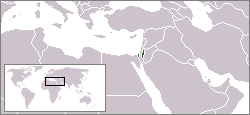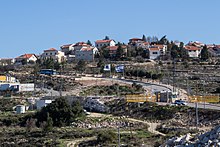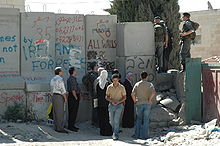| location | |
 | |
| flag | |
 | |
| Short dates | |
| Capital | East Jerusalem (claimed); Ramallah (Seat of government) |
|---|---|
| Form of government | Autonomous Region |
| currency | New Israeli Shekel (NIS, ₪) |
| surface | 27,000 km² |
| population | 3,647,875 (2003; of which West Bank 2.313.609, Gaza Strip 1.334.266) |
| languages | Arabic; other languages: English and Hebrew |
| Religions | mostly Muslims; Jews and large Christian minority |
| Phone code | 972 |
| Internet TLD | .ps |
| Time zone | CET 1h |
Palestine or the Palestinian Territories lie in near East. Geographically, Palestine denotes the entire area of the State of Israel, which was proclaimed in 1948, with the West Bank and Gaza Strip occupied since 1967. There is still no “State of Palestine”, although there have been negotiations between Israel and the Palestinians were led to achieve Palestinian independence. Swiss diplomats speak of the "occupied Palestinian territory."
A future state is said to be in the area of West Bank and Gaza Strip arise; The West Bank, in particular, is still largely under Israeli administration, and the arbitrary creation of Jewish settlements and the erection of fences along roads have resulted in a completely fragmented area.
background
Until the 1967 war, the West Bank was part of Jordan, the Gaza Strip was part of Egypt. The Palestinian Autonomous Territories on the West Bank are a patchwork of the diplomats in the Oslo Agreement have cobbled together.
Regions
.png/220px-West_Bank_&_Gaza_Map_2007_(Settlements).png)
The Palestinian Territories consist of two non-contiguous regions: the smaller region is that of the Gaza Strip, a densely populated coastal strip between southern Israel and Egypt Sinai. The region with the larger area is the one further east and northeast West Bank, sometimes too West bank called that between Israel and Jordan lies; the Jordan and the Dead sea form the eastern border of this area.
Cities
- The Israeli occupied East Jerusalem.
West Bank
A significant number of foreign visitors are religiously motivated and would like to visit the places described in the legends of the Christian Bible:
Gaza Strip
getting there
A passport that is valid for at least six months is required to enter the country. There is no need to apply for a visa. Entry and exit into the West Bank is only possible via Israeli-controlled entry / exit points. Experience has shown that Palestine is cordoned off and entry / exit points are closed on high Jewish holidays.[1] Armed clashes can occur at the checkpoints controlled by Israel. The one between Jerusalem and Ramallah 1 Checkpoint Qalandia(31 ° 51 '42 "N.35 ° 13 ′ 41 ″ E) is particularly affected.
The touristic Entry into the Gaza Strip has not been possible since 2014.
Foreign exchange regulations
The import or export of funds (cash, personal checks, travelers checks) worth a total of 80,000 shekels must be reported. The corresponding “Customs Form No. 84” can be requested by calling 972-2-658 7777.
By plane
Arriving by plane is therefore usually via the Israeli one Ben Gurion Airport at Tel Aviv or another Israeli airport, travelers to the West Bank often use Amman Airport (Jordan) and travel from Jordan to the West Bank via the Allenby Bridge.
The Israeli air force bombed the EU-funded Gaza airport. It is still closed in 2019.
By train
There are no rail connections to the Palestinian Territories.
By bus
In the street
If the authorities allow it, entry from Israel is possible. There is one from the West Bank Border crossing to Jordan (King Hussein / Allenby Bridge), from the Gaza Strip there is also a transition to Egypt.
At the moment, Egypt has its Border with the Gaza Strip opened again. However, only Palestinians (and diplomats etc.) are allowed to enter and exit via this border crossing. Therefore only the checkpoint in Erez remains for foreigners - but this requires a special permit, which is very difficult to get.
Visiting these cities, which are located in the so-called A and B area, is generally not permitted with an Israeli rental car.
By boat
Entry by ship is currently not possible because the Gaza Strip has been sealed off for years by an Israeli sea blockade.
mobility
Local public transport consists mainly of (modern) VW minibuses and some larger buses. The minibuses, Servis called, drive as soon as they are full (each seat is occupied by one person) and are not "packed" too full and there are very many so you never have to wait too long. The driving style is also rather defensive, as the country is quite hilly and winding on the one hand, and on the other hand the many checkpoints obstruct the traffic.
An alternative is a taxi, where you have to negotiate a flat rate beforehand. If you rent the taxi for the whole day, 100 dollars should be enough, possibly half if you are able to negotiate.
language
A local dialect of Arabic is spoken. The Jewish settlers usually speak Hebrew. Most of the time, you will find people with English skills at the tourist attractions.
shop
As everywhere in the region, the “weekend” is primarily based on the religion of the business owner. The day of rest can therefore be Friday, Saturday or Sunday. Opening times are usually 8:00 a.m. to 1:00 p.m. and 4:00 p.m. to 7:00 p.m. or later.
There is little to buy that is of interest to tourists. The usual souvenirs can be found right at the tourist attractions.
kitchen
The food hardly differs from that of other countries in the Middle East, such as the Lebanon.
Learn
public holidays
Public holidays are Jan 1st: New Year, May 1st: Labor Day, “Independence Day:” Nov 15th and Christmas only on Dec 25th.
Then there are the moving Muslim Ras as-Sana (August 10, 2021), the Islamic New Year celebrations on the 1st of Muharram. Isra and Mi'raj is the "Ascension of Muhammad," in which the mosque in Jerusalem is of central importance. First (April 12, 2021) and last (May 12, 2021) day of the fasting month of Ramadan, i.e. beginning of Id al-Fitr, on the 1st show whale (May 13, 2021) - two to four day fasting festival. Four-day Islamic Festival of Sacrifice (ʿĪd al-Aḍḥā), which begins on 10th Dhū al-Jiddjah (July 19, 2021). Birthday (Mulid / maulid) of the Prophet Mohammed on the 12th Rabi 'al-auwal (October 19, 2021).
security

Police: ☎ 100
Emergency doctor: ☎ 101
Fire department: ☎ 102
As a tourist you don't automatically live dangerously in Palestine. Arabs (or those who look like them) are in principle more precisely controlled, a German passport means that any control is often dispensed with. If the accompanying taxi driver carries a German camera and you say that during the check, then he will not be checked either. This does not always have to be the case, of course, but it shows that the needs of tourists are given priority.
Larger gatherings of people, especially demonstrations, should be avoided in any case, as these often become violent and the law enforcement officers then use firearms. Armed attacks by the Israeli army can also occur at any time. Often the houses and livelihoods (e.g. olive groves) of entire families are destroyed if only one family member is suspected of anti-Israeli activities. Court orders or convictions are not a prerequisite.
health
See the notes on hospitals in the relevant local articles.
climate
The climate is no different from that in Israel.
Practical advice
Consulates of European states, usually called “representative offices”, are in Ramallah.
To Post and Telecommunications what has been said about Israel applies. General experience shows that parcels from abroad take longer to travel to the occupied territories than to Israel.
literature
See also travel guide too Israel.
- Alternative Tourism Group (Editor); Valeria Buß, Ellen Hexges (translator): Palestine travel guide: history-politics-culture-people-cities-landscapes, Heidelberg 2013 (Palmyra Verlag); ISBN 978-3-930378-80-7
- Barʿam, Nir; Lemke, Markus; In the land of desperation: an Israeli travels to the occupied territories; Munich 2016 (Hanser; Federal Agency for Civic Education); ISBN 978-3-8389-0790-1
- Böhme, Jörn; Sterzing, Christian; Brief history of the Israeli-Palestinian conflict; Frankfurt 82018 (Wochenschau Vlg.)
- Engelhardt, Marc; Excluded: a trip around the world along walls, fences and abysses; Munich 2018 (dva); ISBN 9783641226336
- Faṛhāt-Nāṣir, Sumaiya H .; A Life for Peace: Reader from Palestine; Basel ²2019 (Lenos); ISBN 9783857874796
- Schäuble, Martin; Instructions for use for Israel and Palestine; Munich 2016 (Piper)
- Melzer, Abraham; Israel in court; Frankfurt 2015 (Zambon)
- Szepesi, Stefan; WALKING PALESTINE: 25 journeys into the west bank; 2012, ²2019 (Interlink); ISBN 9781623719272 [West Bank hiking guide.]
- Waldman, Ayelet; Chabon, Michael; Abarbanell, Bettina; Olives and Ashes: Writers report on the Israeli occupation in Palestine; Cologne 2017 (Kiepenheuer & Witsch); ISBN 9783462049787
Web links
The Israel Tourist Office has not provided any information since 2009.
- Detailed map showing the administrative status of A, B, C areas in the West Bank






